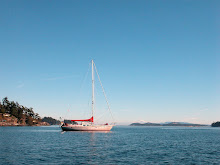It took patience and determination to make our way south in headwinds and ice. Both prevented us from maintaining any form of straight course, adding distance and slowing our progress. The sea ice reduced rapidly as we headed south only to be replaced by a heavier concentration of icebergs and a few more intense rounds of hide and seek in the fog to keep things interesting. We were optimistic that we would be able to anchor in Sonder Skjoldungesund, 175 miles south of Tasiilaq (Ammassalik), getting close to shore to check closer options was impossible due to heavy ice.
80 miles into our extended journey, the engine overheat alarm went off as we were motoring along admiring the icebergs. Krystina immediately shut the engine down and Frances went into the engine room to see if there was an obvious problem. No water was coming in at the strainer and the seacock wouldn't shut off, meaning there was something caught in the saltwater intake. When the drain snake failed to remove the blockage, the next option was to take the hose apart. Once apart, there was a straight shot to the through hull and we just needed to find a long stick to force the blockage out. Krystina suggested the bilge pump handle (a metal rod), which worked beautifully, and seawater once again flowed through the hose. Frances quickly inserted a tapered wooden plug into the hose to stop the water from gushing into the engine room while she shut the seacock off so the hose could be reconnected. We still don't know what got stuck in the intake but our fix worked and we continued motoring. Knowing that in East Greenland, like in most of the places we sail, you have to be completely self-sufficient: you break it, you fix it.
Just over halfway, we tried sneaking in closer to land but the iceberg concentration was too high even at 13 miles out. Krystina changed course to head further from land and also decided that since it was dark, she would take advantage of the calm conditions and let Snow Dragon ghost along on just her mainsail for 3 hours until the sun started to rise. The current prevented us from losing ground and we had enough wind to maintain steerageway.
There wasn't much to be gained when we extended our distance from shore to 26 miles. We still had to carefully weave our way around numerous icebergs then slowly make our way back towards shore when we neared Sonder Skjoldungesund. Watching the landscape of East Greenland unfold before us, the jagged teeth like mountains, regular visits from fin whales and admiring the unique shape of each iceberg was more than enough motivation to continue.
6 days after leaving Isafjordur, we finally dropped anchor at Amitsuarssuq (Caroline Amalies Havn) on the south side of Sonder Skjoldungesund. A small anchorage surrounded by bubbly granite and narrow entrance that was nerve racking to take Snow Dragon through but did an excellent job of keep icebergs out. The anchorage did not have enough room for Snow Dragon to swing freely at anchor and we needed to take a stern line ashore to make sure Snow Dragon didn't drift into the rocks. We had put our dinghy on deck for the crossing and it took a bit of time to get it back in the water and put the motor back on. Krystina remembered to load the rifle just in case and kept polar bear watch while she kept Snow Dragon in position for the stern line to be attached. That way Frances could focus on finding something to tie to on shore without having to worry about managing the large bag of line and the rifle in the dinghy.
Once Snow Dragon was secure, it was time for our first full night of sleep since leaving Iceland. Though we were both tired, it took a while to convince ourselves that it was OK to sleep, our brains still thinking we needed to be at the helm conning through ice. Not sleeping for 9 hours.
We spent our first day at anchor vacuuming, washing clothes and repairing our reefing winch before eventually going to shore in the late afternoon. Earmuffs and rifle in hand for target practice, a Snow Dragon tradition when first arriving in polar bear country before setting off on our hike. We used an old cruising handbook as a target, placed 40 yards away. Neither of us had fired a rifle in 3 years and were surprised when we both managed to hit the target with a single shot. When we collected the book, we realized we had been shooting at the quarantine regulations for New Zealand. Hopefully, our aim will never need to be tested on anything more than a few bits of paper.
Posted by satellite email, photos will be added when we next have internet access.
Friday, August 9, 2013
Subscribe to:
Post Comments (Atom)

No comments:
Post a Comment